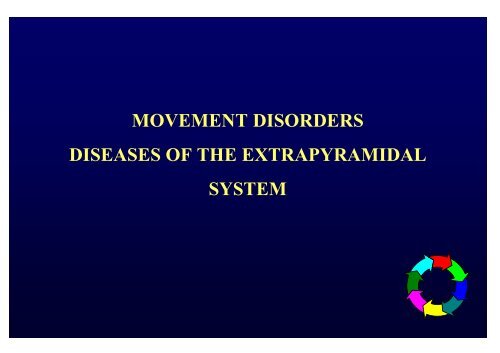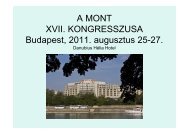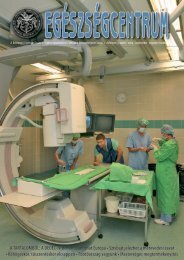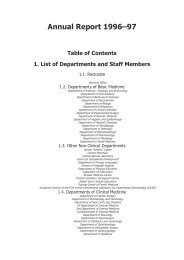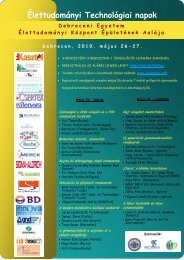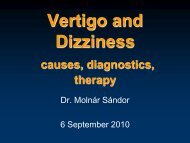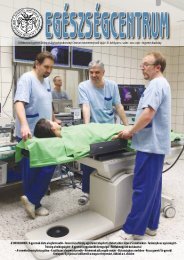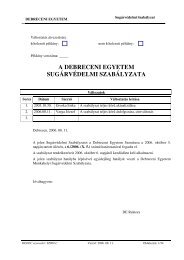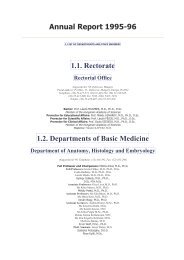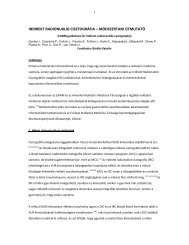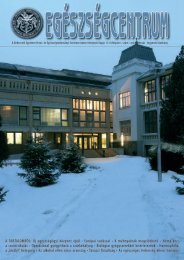movement disorders diseases of the extrapyramidal system
movement disorders diseases of the extrapyramidal system
movement disorders diseases of the extrapyramidal system
You also want an ePaper? Increase the reach of your titles
YUMPU automatically turns print PDFs into web optimized ePapers that Google loves.
MOVEMENT DISORDERS<br />
DISEASES OF THE EXTRAPYRAMIDAL<br />
SYSTEM
The <strong>extrapyramidal</strong> <strong>system</strong> ...<br />
includes all that centers and<br />
pathyways, wich responsible for <strong>the</strong><br />
organisation <strong>of</strong> <strong>movement</strong>s with <strong>the</strong><br />
exception <strong>of</strong> <strong>the</strong> pyramidal tract.
The function <strong>of</strong> <strong>the</strong> <strong>extrapyramidal</strong> <strong>system</strong><br />
• coordination <strong>of</strong> <strong>the</strong><br />
<strong>movement</strong> behavior<br />
• ensurance <strong>of</strong> <strong>the</strong> order<br />
and „smooth” <strong>of</strong><br />
<strong>movement</strong>s
Parts <strong>of</strong> <strong>the</strong> <strong>extrapyramidal</strong> <strong>system</strong><br />
• cortical centers: <strong>the</strong>re are centers in all <strong>the</strong> cortical<br />
lobes<br />
• subcortical centers:<br />
• caudate nucleus<br />
• putamen<br />
• pallidum<br />
• subthalamical nucleus (Luys)<br />
• nucleus ruber<br />
• substantia nigra<br />
• reticular formation<br />
striatum<br />
nucleus lentiformis
There are two main clinically different groups<br />
caused by <strong>the</strong> disease <strong>of</strong> <strong>the</strong> <strong>extrapyramidal</strong><br />
<strong>movement</strong> <strong>system</strong>:<br />
• hypokinetic-hypertonic<br />
(rigid)<br />
• hyperkinetic-hypotonic
hypokinetic-hypertonic (rigid)<br />
syndrome<br />
Parkinsonism
The etiology <strong>of</strong> <strong>the</strong> Parkinsonism<br />
• primer, idiopathic form: Parkinson’s disease<br />
- <strong>the</strong> second most frequent progressive neurodegenerative<br />
disease<br />
- <strong>the</strong> prevalence is 1% in <strong>the</strong> 65 year old population and it<br />
increases to 4-5% in <strong>the</strong> 85 year old population<br />
- it is most frequently sporadic<br />
- approximately 10% <strong>of</strong> <strong>the</strong> cases are familiar (<strong>the</strong>re are 10<br />
indentified genes, wich cause autosomal dominant, or<br />
recessive forms <strong>of</strong> Parkinson’s disease)
The etiology <strong>of</strong> <strong>the</strong> Parkinsonism<br />
• symptomatic: Parkinson’s syndrome<br />
– trauma<br />
– tumor<br />
– inflamation (encephalitis)<br />
– stroke (ischemic, hemorrhagic)<br />
– toxic agents (CO, neuroleptic drugs)
The neuropathologic basis <strong>of</strong> Parkinson’s disease<br />
• degeneration <strong>of</strong> <strong>the</strong> substantia nigra and <strong>the</strong><br />
striatum (Lewy bodies- citoplasmatic protein<br />
aggregations)<br />
• disintegration <strong>of</strong> <strong>the</strong> dopamin-acetilcholin<br />
balance in <strong>the</strong> central nervous <strong>system</strong><br />
• decrease <strong>of</strong> <strong>the</strong> dopamin level and cholinergic<br />
dominance
<strong>the</strong> main symptoms <strong>of</strong> Parkinsonism<br />
• rigidity<br />
• tremor<br />
• hypo-, and bradykinesis<br />
• postural instability
igidity<br />
• <strong>the</strong> tone <strong>of</strong> <strong>the</strong> agonist és antagonist (flexor and<br />
extensor) muscles increases paralelly<br />
• <strong>the</strong> trunk and <strong>the</strong> extremities are in semiflected<br />
position<br />
• during passive <strong>movement</strong> <strong>of</strong> <strong>the</strong> extremities we<br />
can feel permanent resistance (cogwheel<br />
phenomenon)<br />
• very <strong>of</strong>ten assimetrical distribution
tremor<br />
• <strong>the</strong> agonistic and antagonistic (flexor és<br />
extensor) muscles contract with rhytmic, 6-<br />
8/sec. frequency<br />
• <strong>the</strong> tremor is most prominent in resting<br />
position, <strong>the</strong> stress could provoke it<br />
• <strong>the</strong> intended <strong>movement</strong>s decrease <strong>the</strong> tremor<br />
and it is stopped during sleep<br />
• very <strong>of</strong>ten assimetrical distribution
hypo-, and bradykinesis<br />
• <strong>movement</strong>s and walking become slow, sluggish<br />
and difficult<br />
• shuffling gait with decreased excursion <strong>of</strong> legs<br />
• difficulties in turning<br />
• freezing: sudden stop in walking and <strong>movement</strong>s
o<strong>the</strong>r signs<br />
• on-<strong>of</strong>f phenomenon<br />
• retropulsion<br />
• hypomimia, or blank facies<br />
• hypersalivation<br />
• monotonous speech<br />
• micrographia<br />
• hyposmia, hypogeusia<br />
• constipation<br />
• depression
<strong>the</strong> Parkinsonic crisis could be life<br />
• complete immobility<br />
• aphagia and anarthria<br />
• extreme rigidity<br />
• fever<br />
threatening !!<br />
• cardiovascular inssufficiency<br />
• bedsores, pneumonia, deep vein thrombosis,<br />
lung embolism
treatment<br />
DRUGS<br />
• MAO B inhibitors (Selegilin, Jumex, Rasagiline)<br />
• Amantadin (Viregyt K, PK Merz)<br />
• Dopamin agonists (ergotamine type:Bromocriptin,<br />
non ergotamin type: Requip,Mirapexin, Apomorphin)<br />
• L-DOPA substitution (L-DOPA+DOPA decarboxilase<br />
inhibitor pl.Madopar, Sinemet, Duellin)<br />
• COMT inhibitors (Comtan)<br />
• L-DOPA+DOPA decarboxilase inhibitor+ COMT inhibitor<br />
(Stalevo)<br />
• anticholinergic drugs (Tremaril, Kemadrin, Akineton)
The scheme <strong>of</strong> <strong>the</strong> recommended treatment <strong>of</strong> Parkinson’s disease in 2004<br />
Parkinson’s disease<br />
treatment with drugs<br />
?neuroprotection<br />
„non drug” treatment<br />
education<br />
OLANOW<br />
functional deficit<br />
help and support<br />
exercises, physical education<br />
observation<br />
no<br />
yes<br />
nutrition (low protein)<br />
Dopamin agonists<br />
1-dopa (+/- COMT-1)<br />
Dopamin agonists 1-dopa (+/- COMT-1)<br />
COMT-1 (if <strong>the</strong>re was not tried)<br />
Motor complications<br />
If <strong>the</strong> treatment with drugs is not enough= neurosurgical treatment
treatment<br />
SURGICAL (just in very severe cases, when <strong>the</strong><br />
antiparkinson drugs are uneffective)<br />
• deep brain stimulation – DBS (uni-, or bilateral)<br />
• thalamotomy, pallidotomy (uni-, or bilateral)<br />
• neurotransplantation (inplantation <strong>of</strong> fetal<br />
mesencephalic cells into <strong>the</strong> caudat nucleus and<br />
putamen region)
treatment<br />
• physico<strong>the</strong>rapy (training, special exercises)<br />
• psycho<strong>the</strong>rapy
<strong>diseases</strong> characterized with hyperkinesis<br />
and hypotonia<br />
• chorea<br />
• ballism<br />
• a<strong>the</strong>tosis<br />
• dystonias<br />
• myoclonus<br />
• tic
Chorea<br />
• features: irregular, sudden onset, fast <strong>movement</strong>s<br />
wich involve first <strong>of</strong> all <strong>the</strong> distal part <strong>of</strong> extremities,<br />
but could appear in <strong>the</strong> truncal, facial and tongue<br />
muscles as well<br />
• <strong>the</strong> emotional effects, stress could provoke it<br />
• <strong>the</strong> anatomical basis is <strong>the</strong> degeneration <strong>of</strong> <strong>the</strong><br />
putamen and <strong>the</strong> caudat nucleus
Chorea<br />
• forms:<br />
– inherited (Huntington chorea, autosomal dominant)<br />
– symptomatic (chorea minor, chorea gravidarum,<br />
caused by traumas, tumors, inflamation, stroke in <strong>the</strong><br />
above mentioned brain regions)
allism<br />
• features: violent, big <strong>movement</strong>s in <strong>the</strong> proximal<br />
muscles <strong>of</strong> <strong>the</strong> extremities with sudden onset.<br />
Because <strong>of</strong> <strong>the</strong>se <strong>movement</strong>s <strong>the</strong> patient can fall<br />
down.<br />
• anatomical basis: <strong>the</strong> degeneration <strong>of</strong> <strong>the</strong><br />
subthalamical nucleus (Luys)<br />
• forms:<br />
– idiopathic<br />
– symptomatic ( caused by traumas, tumors,<br />
inflamation, stroke in <strong>the</strong> above mentioned brain<br />
regions)
a<strong>the</strong>tosis<br />
• features: slow, „vermin-like” <strong>movement</strong>s in <strong>the</strong> distal<br />
muscles <strong>of</strong> <strong>the</strong> limbs, but <strong>the</strong> facial muscles could be<br />
involved as well<br />
• anatomical basis: <strong>the</strong> degeneration <strong>of</strong> <strong>the</strong> striatum<br />
and <strong>the</strong> pallidum<br />
• forms:<br />
– idiopathic<br />
– symptomatic (caused by traumas, tumors,<br />
inflamation, stroke in <strong>the</strong> above mentioned brain<br />
regions)
treatment<br />
• dopamin antagonist: tiaprid (Tiapridal)<br />
• chlorpromazin (Hibernal)<br />
• Haloperidol<br />
• clonazepam (Rivotril)<br />
• amantadin
dystonias (torticollis, tortipelvis, antero-,<br />
retrocollis)<br />
• features: dystorsion <strong>of</strong> <strong>the</strong> neck, limbs and trunk because <strong>of</strong> elevated<br />
muscle tone<br />
• etiology: <strong>the</strong> degeneration <strong>of</strong> <strong>the</strong> putamen, psychogenic problems:<br />
anxiety, depression<br />
• forms:<br />
– idiopathic<br />
– symptomatic (caused by traumas, tumors, inflamation, stroke in <strong>the</strong><br />
above mentioned brain regions, side effect <strong>of</strong> : neuroleptic drugs,<br />
thietylperazine (Torecan), metoclopramide (Cerucal), domperidone<br />
(Motilium)
treatment<br />
• local infiltration <strong>of</strong> <strong>the</strong> involved muscles with botulinum<br />
toxin<br />
• L-Dopa (in L-Dopa resposive forms)<br />
• Anticholinergic/antihistaminic agents: trihexyphenidyl<br />
(Artane), Procyclidine (Kemadrin), ethopropazine<br />
(Parsidol)<br />
• Bacl<strong>of</strong>en<br />
• Clonazepam (Rivotril)<br />
• Antiepileptic drugs: Carbamazepine (Tegretol, Neurotop),<br />
Gabapentin (Neurontin, Gordius)<br />
• Dopamine-depleting agents: Tetrabenazine, Reserpine<br />
• Dopamin antagonists: Tiapridal
myoclonus<br />
• features: fast, irregular <strong>movement</strong> <strong>of</strong> a muscle group, or a<br />
muscle region <strong>of</strong> <strong>the</strong> body. It involves first <strong>of</strong> all <strong>the</strong> distal part<br />
<strong>of</strong> <strong>the</strong> body and axial muscles, or <strong>the</strong> palatal muscles<br />
• The anatomical basis could be cerebral (cortical, subcortical),<br />
and spinalis lesions, or <strong>the</strong> degeneration <strong>of</strong> <strong>the</strong> so called<br />
„myoclonic triangle”: nucl. ruber, nucl. dentatus, oliva inferior<br />
• forms:<br />
– idiopathic<br />
– associated with epilepsy<br />
– symptomatic
treatment<br />
• clonazepam (Rivotril)<br />
• carbamazepine (Tegretol, Neurotop)<br />
• levetiracetam (Keppra)<br />
• valproic acid (Convulex, Depakine)<br />
• piracetam (Nootropil)
tic<br />
• features: irregular, stereotyped, fast <strong>movement</strong><br />
<strong>of</strong> a muscle group with sudden onset, or could<br />
be<br />
• stereotyped repetition <strong>of</strong> words, wich most<br />
frequently obscene words (Gilles de la Tourette<br />
syndrome: both multiple motor and vocal tics,<br />
for at least 1 year, tics changing over time, <strong>the</strong><br />
onset <strong>of</strong> tics before <strong>the</strong> age <strong>of</strong> 21 years)
treatment<br />
• dopamine receptor antagonists: Haloperidol,<br />
Risperidon (Risperdal), Ziprasidone (Ziprexa)<br />
• α2 agonists: Clonidine<br />
• monoamin depletors: Tetrabenazine<br />
• clonazepam (Rivotril)<br />
• SSRI-s: Paroxetine, Citalopram,<br />
Venlafaxine…stb


